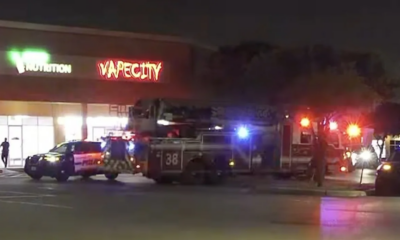Preparedness
24 Everyday Items You Should Never Throw Away for Survival

In a world where convenience often trumps conservation, many of us are guilty of tossing out items that could be repurposed for survival. Our grandparents knew the value of reusing and recycling, and it’s time we took a page from their book. The following list reveals everyday items that you might typically discard but can actually be lifesavers in emergencies. From fire starters to makeshift tools, these items might just be the difference between comfort and crisis.
1. Plastic Bottles
Don’t throw out those plastic bottles just yet. They are perfect for storing clean water in emergencies and can be used to create solar stills or even fishing traps.
2. Broken Umbrellas
Save the parts of a broken umbrella! The metal spokes and fabric can be repurposed for building shelters, while the handle can serve as a makeshift spear or digging tool.
3. Plastic Pool Floats
Even with holes, plastic pool floats are waterproof and can be used for insulation. Cut them into strips to make small waterproof storage bags or repair them for flotation devices.
4. Old Newspapers
Old newspapers are excellent for starting fires and providing insulation. They can even be used to make emergency bandages.
5. Toilet Paper and Paper Towel Rolls
Stuff these rolls with dryer lint or other flammable materials for a great fire starter. They also work well as biodegradable seed starters.
6. Dryer Lint
Highly flammable, dryer lint is an excellent fire starter. Combine it with toilet paper rolls, and you’re set for starting a fire in an emergency.
7. Crayons
Crayons can burn for up to thirty minutes, making them useful as small candles or fire starters in a pinch.
8. Nearly Empty Petroleum Jelly Jars
Even a little petroleum jelly can be used as a fire accelerant or to waterproof matches. Combine it with cotton balls for a fire-starting balm.
9. Aluminum Cans
Don’t toss that soup can! Aluminum cans can serve as makeshift cooking pots, alarm systems, signal mirrors, and even small solar ovens.
10. Glass Jars
Glass jars are invaluable for storing food and water in emergencies. They can also be used to make lanterns or emergency fire starters when soaked in alcohol.
11. Plastic Bags
Versatile plastic bags can be used for waterproofing, collecting water, carrying items, or even creating makeshift shelters.
12. Cardboard Egg Cartons
Combine with lint for an excellent fire starter. Cardboard boxes can also be used for insulation, fire kindling, carrying items, or building temporary shelters.
13. Empty Prescription Bottles
These bottles are perfect for waterproof containers for matches or tinder. They can also be transformed into small emergency fishing kits.
14. Insoles from Worn-Out Shoes
Use these as improvised insulators to add warmth to emergency footwear or gloves, especially in colder conditions.
15. Old Shoelaces
Shoelaces can be used as cordage for building shelters, setting traps, or tying things together in an emergency.
16. Candle Fragments
Melt down leftover candle wax to create waterproof matches or enhance kindling. Fragments can also be used to start fires with the sun’s help.
17. Gum Wrappers
Feeling like MacGyver? Use a gum wrapper with a battery to start a fire. It’s a handy trick in a tight spot.
18. Soda Tabs
Modify soda tabs to create fishing hooks or use them as emergency tools. Toss one in your prescription bottle fishing kit for good measure.
19. Wine Bottles
Wine bottles can be used to carry water, signal for help, or be heated in the sun for warmth. They’re more than just décor!
20. Old T-Shirts
Rip old t-shirts into strips for bandages or tourniquets. Char the cloth for fire-starting, or use it for makeshift water filtration.
21. Tin Foil
Tin foil can serve as a reflective signal, insulator, or even as a makeshift frying surface when cooking.
22. Broken Electronics
Before discarding electronics, see if you can salvage parts like copper wiring, which is useful for traps, fishing lines, or emergency repairs.
23. Old Lip Balm
Old lip balm can be used as a fire accelerant or to soothe cracked skin in harsh conditions.
24. Paper Clips
Malleable paper clips can be bent and used as small tools, fishing hooks, or improvised locks.
In conclusion, before you toss out what seems like useless junk, consider the potential survival uses of these everyday items. With a little creativity and resourcefulness, you can turn trash into treasure, ensuring you’re prepared for any emergency that might come your way. Remember, it’s not just about survival; it’s about thriving in unexpected situations.
Let us know what you think, please share your thoughts in the comments below.

Preparedness
Unlock the Art of Self-Sufficient Brewing at Home

For those seeking greater self-sufficiency on their homestead, crafting your own beer, wine, and mead can be both a rewarding and practical endeavor. Whether or not you’re a fan of alcoholic beverages, the knowledge of homestead brewing can be invaluable, especially as a potential barter item in challenging times.
For enthusiasts, homestead brewing offers the chance to tailor recipes to your personal taste. Beyond the satisfaction of creating a unique brew, you can also save money by producing your own beverages instead of purchasing them from the store. The initial investment in brewing equipment is relatively low, and you may already own some of the necessary tools. The Today Show notes, “Based on the cost of a 12-pack of fizzy yellow beer, it’ll take less than four batches before your equipment costs are covered and you have a beer fridge stocked with craft-quality beers that you brewed at less than Bud Light prices.”
Starting your brewing journey requires some basic knowledge and equipment. While homestead brewing is generally safe, caution is advised during the bottling stage. As with canning, bottles with excessive sugar can explode, potentially causing injury with flying glass shards. Additionally, while brewing is legal across the United States, each state has specific regulations regarding alcohol content, ingredients, and permits. Importantly, selling your homemade brews is illegal.
The process of homestead brewing involves combining a sugary liquid with yeast and allowing it to ferment over time. The variations between beer, mead, and wine largely depend on the ingredients and specific steps in the fermentation process. Many of the tools used in brewing are versatile and can be applied to different types of beverages. Essential equipment includes chemicals for improving shelf life and clarifying, such as potassium metabisulfite and pectic enzyme, as well as different types of yeast depending on what you are brewing.
For a straightforward introduction to brewing beer, consider a simple SMASH (Single Malt And Single Hop) ale recipe. Heat six gallons of water and add malt extract as it approaches boiling. Introduce hops at three intervals during the boil, then cool to 68ºF and pitch your yeast. After a week to ten days of fermentation, check the final gravity. If it reads 1.013 or close, you can proceed to bottling or kegging.
Mead, often associated with the Medieval Ages, offers a different brewing experience. The process is similar to beer brewing but substitutes honey for malt extracts and typically omits hops. Mead requires patience, as it takes longer to ferment and mature. A basic mead recipe involves dissolving honey in water, adding fruit juices, and allowing it to ferment in a cool, dark place for several months before bottling.
For those with an abundance of homegrown fruits, crafting fruit wine is a delightful way to enjoy the fruits of your labor. A strawberry wine recipe begins by defrosting frozen fruit with sugar and pectic enzyme, then mashing the berries and combining with yeast and other ingredients. The mixture is allowed to ferment, first in a primary stage and then in a secondary fermentation until the wine is “still,” indicating no carbonation. After bottling, the wine should be aged for at least 30 days, though six to 12 months is recommended for optimal flavor.
Homestead brewing is not just a skill but an art form that allows you to create beverages that reflect your personal taste and creativity. With patience and practice, you can master the craft and enjoy the satisfaction of producing your own delicious drinks.
Let us know what you think, please share your thoughts in the comments below.
Preparedness
Unlock Your Home’s Secret Arsenal for Self-Defense

In today’s world, the need for personal safety is more pressing than ever. With violent crimes and property crimes occurring at alarming rates, it’s crucial to be prepared for unexpected situations. While many of us may not have access to conventional weapons in a crisis, everyday household items can serve as effective tools for self-defense.
The key to using household items for protection lies in quick thinking and resourcefulness. As self-defense expert Jennifer Cassetta advises, tapping into your primal instincts can be crucial: “For me, when I was grabbed on the street in New York when I was living there, I said ‘I released my inner She-Beast’ that night. We all have this power within, like animals in the wild, protecting their young.”
In the kitchen, you’ll find an arsenal of potential weapons. A cast iron skillet, for example, is heavy enough to cause significant harm to an assailant. Knives can be used for cutting or piercing, while spices like chili powder can temporarily blind an attacker. Even vinegar, with its acidic properties, can serve as a distraction.
Your home office also holds items that can be repurposed for defense. Pens and scissors can be used to target vulnerable areas of an attacker’s body. A stapler, thrown or used as a blunt object, can slow down an intruder.
Tools from your garage or garden can be equally effective. A screwdriver can pierce sensitive parts, while gardening tools like shovels or hoes can keep an attacker at bay. Sports equipment, such as bats or racquets, can also be utilized to fend off threats.
Chemicals stored in your home are another line of defense. A fire extinguisher can be sprayed or used as a blunt instrument. Insect sprays, particularly those for hornets or wasps, can incapacitate an attacker from a distance. Bleach and hairsprays can serve as irritants, while perfumes can disrupt vision and breathing.
Heavy household objects like lamps and books can be used to strike an assailant. Items such as footwear, clothing, and pillows can be thrown to distract or shield yourself. Even everyday items like a hot cup of coffee or a curling iron can be repurposed as defensive tools.
Remember, the goal in a self-defense situation is not to engage in combat but to create an opportunity to escape and seek help. As reiterated, “We are NOT suggesting you fight your attacker.” Instead, focus on using these items to distract or disarm, allowing you to get to safety.
Ultimately, anything within reach can be transformed into a tool for protection. Whether it’s a sock filled with coins, a wire hanger, or a reusable water bottle, being resourceful and prepared can make all the difference in a dangerous situation.
Let us know what you think, please share your thoughts in the comments below.
Preparedness
Start Prepping: Essential Gear Every Beginner Needs

Starting out in the world of prepping can seem daunting, with a myriad of products and information available that can easily overwhelm a newcomer. However, by focusing on the basics, you can begin your journey toward greater self-reliance and emergency readiness with confidence.
The key to effective prepping lies in understanding the fundamental categories of gear every beginner should prioritize. These essentials include water storage and purification, food supplies, first aid, shelter, and navigation tools. By concentrating on these core areas, you can simplify the process and build a solid foundation for your preparedness efforts.
Prepping involves actively preparing for emergencies or disasters by gathering necessary supplies and gear. This mindset fosters self-reliance, crucial when access to utilities, transportation, or stores is disrupted. Having the right equipment and supplies not only reduces panic but can also save lives during crises.
Emergencies can occur without warning, making it wise to be prepared ahead of time. Reliable supplies on hand help to reduce panic, instill confidence, and enable individuals to assist others effectively. “Self-reliance is empowering. Not having to scramble for critical items during a crisis allows people to focus energy on coordination, communication and recovery efforts.”
When beginning your prepping journey, it’s important to resist the urge to invest in specialized tools right away. Instead, concentrate on versatile essentials that address basic needs:
– **Water**: Ensure you have methods for storing and purifying water to prevent dehydration. Consider using systems like the Sawyer Mini or Lifestraw for clean water access.
– **Food**: Stock up on non-perishable nutrition to avoid hunger. Items like rice, beans, pasta, and canned goods are excellent staples.
– **First Aid**: Prepare to treat injuries until professional help arrives. A well-stocked first aid kit is non-negotiable.
– **Light**: Equip yourself with flashlights and lamps to navigate when it’s dark.
– **Shelter**: Pack items like tarps, blankets, and bivvy bags to stay warm and dry.
As you gain experience, you can expand your collection with supplemental items that enhance your capabilities. For now, focus on acquiring durable, reliable items that are easy to transport and use.
Water solutions are among the most critical categories in your survival gear. Every prepper should have multiple methods to store and purify water in case of emergency. “Water purification systems like the Sawyer Mini or Lifestraw to ensure access to clean water.”
In addition to water, maintaining a stockpile of non-perishable food is essential. Consider storing staples such as rice, beans, and pasta in food-grade buckets. Canned goods, boxed items, and spices can help round out your reserves. Aim for at least a three-month supply when possible.
When it comes to survival clothing and shelter, choose versatile, durable fabrics suited for your climate and potential risks. While self-defense tools and skills may not be top of mind, they are prudent precautions for preppers to consider. Firearms and ammunition can provide security and hunting capabilities, but remember to “take appropriate courses and practice routinely with any equipment.”
Communication is another vital aspect of preparedness. Reliable news and connectivity are invaluable during disasters. Emergency radios, maps, two-way radios, and satellite phones help you stay informed, navigate risks, and communicate with others. “Don’t overlook old-school options like compasses and paper maps either.”
As you continue to build your prepping skills and stockpile, remember that self-reliance provides peace of mind and improves your chances of survival when disaster strikes. Start simple with versatile gear for water, food, first aid, shelter, and self-defense, and gradually build up to more advanced equipment as your skills and needs evolve. With the right foundation, you’ll be well-prepared to face whatever challenges come your way.
Let us know what you think, please share your thoughts in the comments below.
-

 Tactical9 months ago
Tactical9 months ago70-Year-Old Fends Off Intruder with Lead-Powered Message
-

 Preparedness6 months ago
Preparedness6 months agoEx-Ballerina’s Guilty Verdict Sends Tremors Through Gun-Owner Community
-

 Tactical9 months ago
Tactical9 months agoVape Shop Employee Confronts Armed Crooks, Sends Them Running
-

 Preparedness4 months ago
Preparedness4 months agoGood Samaritan Saves Trooper in Harrowing Interstate Confrontation
-

 Tactical9 months ago
Tactical9 months agoMidnight SUV Theft Interrupted by Armed Homeowner’s Retaliation
-

 Survival Stories1 year ago
Survival Stories1 year agoEmily’s 30-Day Experience of Being Stranded on a Desert Island
-

 Preparedness4 months ago
Preparedness4 months agoArizona Engineer’s Headless Body Found in Desert: Friend Charged
-

 Preparedness4 months ago
Preparedness4 months agoBoy Saves Dad from Bear Attack with One Perfect Shot